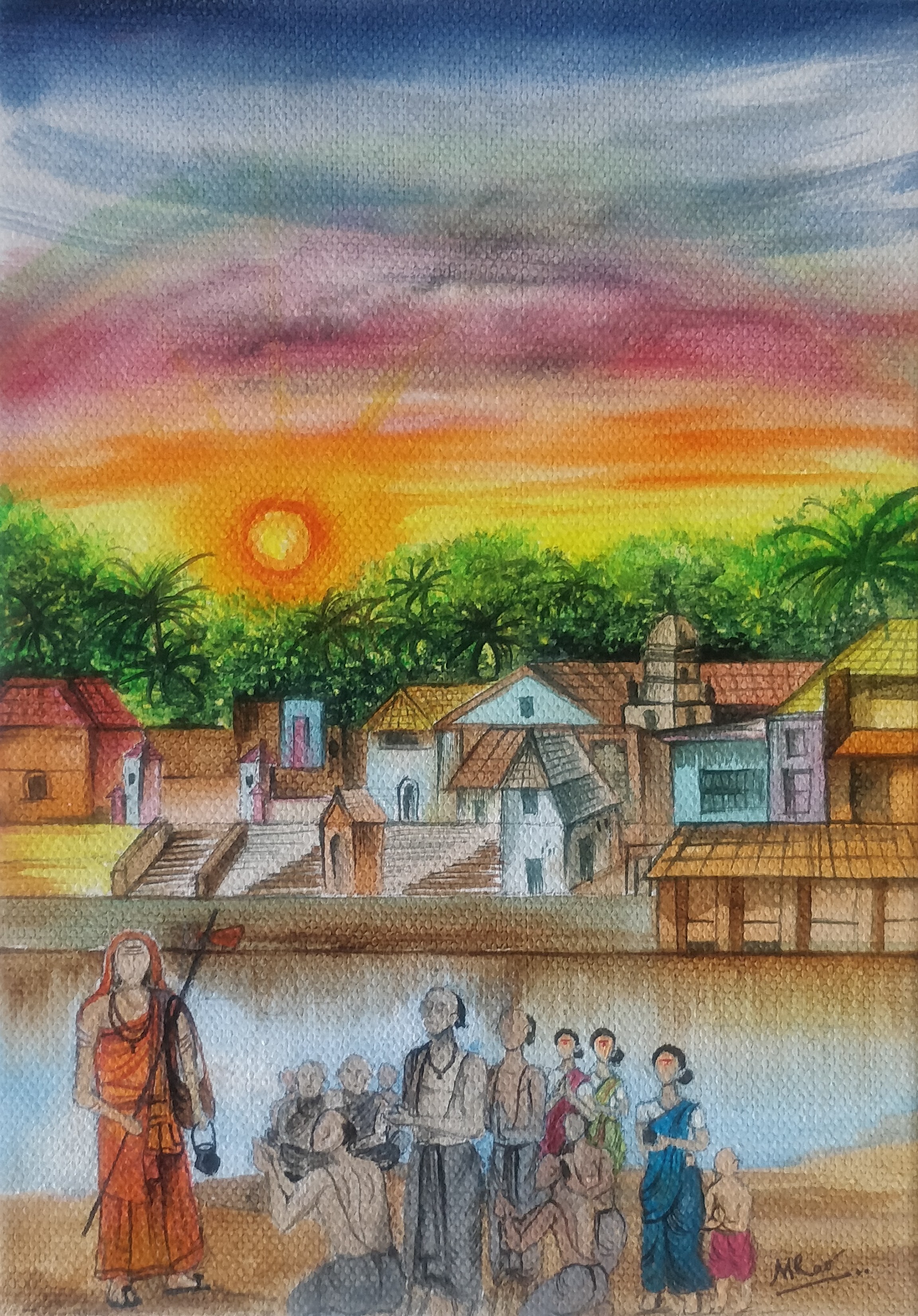RATHASAPTAMĪ AND GURU-PRĀPTI-DIVASA
Rathasaptami, the day that Surya Devata steers his chariot vigorously towards the North, is also the day that heralded the advent of our first Guru, H.H. Shrimat Parijnanashram Swamiji in 1708 CE. More about this auspicious day and it's significance for Chitrapur Saraswats in this article by Dharmapracharaka, Shri V. Rājgopāl Bhaṭ maam, with a specially rendered painting by Yuvati Mitali U Rao.
Rathasaptamī is a festival dedicated to Sūrya, the radiant sun, without whom there can be no life on earth. The sun can indeed be hailed as the fountainhead of life and vitality. Our Vedic ancestors have therefore glorified this luminous celestial orb in the Veda-s and the Upanis͟had-s. The holy Gāyatrī Mantra itself is an invocation to the divine as visualized in the sun. "The Spirit that is in the Sun, that Spirit (Purus͟ha) am I!" declares the Upanis͟had.
The sun is revered in our culture as Sūrya Nārāyaṇa. Rathasaptamī, which falls on Māgha Shukla Saptamī, is a festival of thanksgiving to Him.
Sūrya has been visualized in the Veda-s as traversing the sky riding a golden chariot (ratha). "हिरण्मयेन सविता रथेन देवो याति भुवनानि पश्यन्," proclaims an ancient mantra. The chariot is said to have 12 wheels, representing the 12 signs (each of 30 degrees) of the 360-degree zodiac and constituting a full year, which is called Saṁvatsara. Sūrya’s own house in the almanac is Leo (Siṁha) and He moves from one house to the next every month. This cycle takes 365 days to complete. The Rathasaptamī ceremonies invoke the benevolent cosmic shower of energy and light from the life bestowing Sūrya.
The number seven is considered dear to Sūrya. He is also called Saptāshva, having seven horses yoked to his ratha. These horses symbolize the seven colors that are visible in the spectrum (VIBGYOR). A week has seven days, each of which is heralded by the rising of the sun. Devotees who celebrate Rathasaptamī traditionally offer seven items as naivedya.
Rathasaptamī also marks the gradual increase in temperatures across India and the impending arrival of spring, which is later heralded by Yugādī or the Hindu Lunar New Year day in the month of Chaitra.
Rathasaptamī is also known as Sūrya Jayantī. It is the day on which Vaivasvata (विवस्वान् means the sun) Manvantara (a cycle of time) is believed to have started. It is also said to be the day on which Sūrya was born to Kashyapa and Aditi.
The traditional worship on Rathasaptamī begins with adorning the idol of Sūrya with saffron, flowers, and seven leaves of Arka plant (रूयी पान in Konkani). A bath in a tank or a river at dawn (अरुणोदय) is specially prescribed. The merit (पुण्य) earned from this grateful thanksgiving is said to be unwavering (अचल), and hence this auspicious day is also called Achalāsaptamī. This puṇya is said to wipe out one's sins from the past seven lives and also to confer blessings on seven generations of ancestors, both maternal and paternal!
Tarpaṇa is offered to Sūrya with mantra-s invoking Him. The stotra-s ideal for recitation on Rathasaptamī are Āditya Hṛdaya, Sūryās͟hṭaka, Sūrya-sahasranāma, and Sūryamaṇḍala stotra. In places like Mysore and Melkoṭe, ceremonial processions carry a Sūryamaṇḍala, symbolizing the deity. The annual Rathotsava of Lord Vīra Veṅkaṭesha of Shrī Veṅkaṭramaṇa Temple in Mangalore is also held on this day and is fondly called Koḍiāl Teru.
Rathasaptamī holds even more special significance for us, the Chitrāpur Sāraswat-s. It was on this auspicious day that we were blessed with our first Guru, H.H. Shrīmat Parijñānāshram Swāmījī I at Koṭitīrtha in Gokarṇa.
As very graphically described by revered Ārūr Umābaī in Shrī Chitrāpur Guruparamparā Charitra (chapters three and four), our venerable ancestors sat in the hallowed premises of Shrī Mahābaleshwar Temple, Gokarṇa, to meditate, giving up food and drink, resolving not to give up till the Lord answered their prayers. Seven days passed in this way. Then the prominent among them had a vision of Lord Bhavānīshaṅkar.
The gracious Lord then declared that a Sannyāsī from North India would arrive at Koṭitīrtha on the evening of the next day. That ascetic, an incarnation of the Lord Himself, would gladly consent to be their Guru. That momentous meeting between the Sannyāsī (H.H. Shrīmat Parijñānāshram Swāmījī I) and our elders took place on Rathasaptamī. Therefore, this day is sacred to us as Guru-Prāpti-Divasa.

Though Uttarāyaṇa precedes Rathasaptamī on the calendar, it is from Rathasaptamī that Sūrya is said to steer His chariot northwards vigorously. Indeed, what a splendid coincidence that our Guru-Prapti-Divasa coincides with Rathasaptamī! After all, it was the advent of our first Guru that heralded the Uttarāyaṇa of our Samāja - our Godward march with the venerable Guruparamparā to guide our steps.
